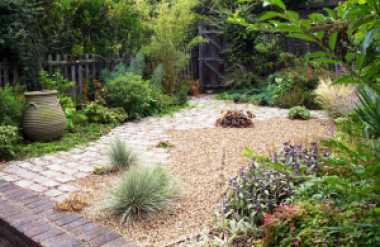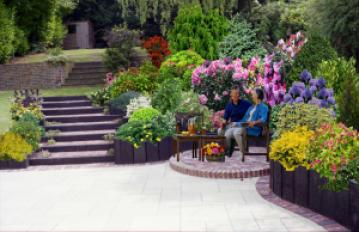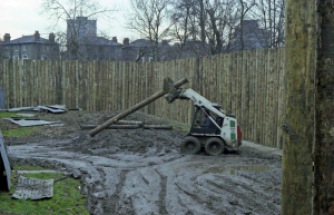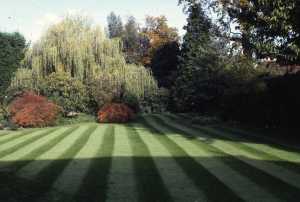Home & Garden
-
Suffering from Allergies?
Ann and I were fortunate to interview Tom Ogren.
Tom is the author of a fascinating ,very informative book about Allergies in the garden.
This is a must read for avid gardeners everywhere. Especially if you are one of the many suffering from allergies.
You can hear our interview with Tom below or at www.growingtrends.org or on iTunes at Growing Trends
We would love to hear your thoughts and comments, please spend a moment sending us your thoughts and suggestions.
Ann & Chris
Podcast: Play in new window | Download
Subscribe: RSS
Views: 281
-
Creating mystery & intrigue with Timber Walls, Fences & Trelliage
Last time we talked about paths.
Today I thought it might be advantageous to discuss ‘Timber Walls & Fences’.
We will include Trelliage as they all have a role to play.
Helping to create a certain kind of mystery within a garden landscape.
We’ve discussed hedges recently, so you can scroll down to that article if you would like.
These ‘vertical materials’ are acting as a visual or physical barrier between differing areas.
This leads the eye on to a new discovery or perhaps just creating an interesting space.
At some time fairly soon we should add ‘Green Walls’ which are gaining in interest and can look absolutely superb.
I wonder how long it is before we develop these to grow vertical edibles ?
Having designed and built a huge number of gardens over the years. We have gained valuable experience in what works best in a given situation.
Using Timber.
The garden below, was primarily designed to reduce aftercare. Taking care to keep the beautifully rustic boundary fencing, which blends in to both the surroundings and the new work so well.
It was necessary, to repair the odd arris rail, a couple of fence posts and some slats, re-hang the side gate etc. Overall by keeping the original fence the rustic feel was, I think, you will agree maintained.

Low hit and miss side fence with 6ft feather edged boundary fence & framed gate Start with what is already there.
It’s nearly always best to work with what is already there, rather than ripping out everything. My first task is always to look up and see how the tree canopy is. Then beyond the space we are working with.
To see what impact, we may be making without perhaps realizing how a neighbor might view our endeavors.

Very low maintenance, Mediterranean style In small gardens complete barriers tend to make the garden smaller. It is best to create more of an illusion of a barrier. This is often best created by using trellis. Here is an example that we stained black.
A word of warning, trying to make a gate from trellis is fraught with problems if you do not add a full frame that is braced. When you add this, it tends to upset the look of the trellis, so think carefully before using as a gate. As without the frame the gate will change shape over time!
Trelliage
The trellis here was primarily to separate the more formal ‘Front Garden’ with the more relaxed ‘Play Garden’ at the rear and side of the property.
To improve the strength of this gate we added metal framing at each corner, both inside and outside, it was only partially successful.

A black stained trellis gate If a more substantial barrier is required, say in the form of a structural wall to hold back a bank then there are a number of ways to achieve this.
Low Timber Retaining wall.
Here we used vertically set timber as a retaining wall. We did place a waterproof membrane behind the timber and a gravel pressure release drain. So as not to have unsightly stains running across the light colored paving.

Low timber retaining wall A quite pleasing effect can be achieved.

The softer low timber wall looks at home here. Roof Gardens
Roof gardens benefit from the light weight of timber. Its ability to be ‘modulised’, as can be seen here.

Low timber walls on roof garden Structural Timber Walls
Some years ago, now, we discovered. Well perhaps I should say a local native of our area wanted someone to test a new product he had found lurking in New Zealand. So, as we had won a number of awards for our work, and our teams were well known, he persuaded us to try this product.

Structural Timber Walls It was fantastic. Ok I should add some provisos, it is treated wood, it lasts a very long time, I have pieces from 30 years ago that are still unblemished. Maybe bleached a little but otherwise fine. It will twist if not constructed correctly, although it is unzippable and thus fairly straightforward to repair. If you introduce plants into the wall, it looks amazing. Infact the plants protect the timber.
Here’s a much taller one we completed.
It is essential to use a structural engineer to carry out the necessary survey, and calculate the design criteria for these ‘Gravity Walls.’
Once established they can look like this..

Planting covering a timber wall 
The timber wall blends in so well Some years back we were even asked to build a play area within a timber stockade. The posts were about 16 ft long and required some ingenuity to place correctly.

Treated timber barrier in play area Here’s how we did it..

Using a 4in1 bucket on a bobcat Moving to more decorative uses, let’s explore trelliage and low walls..

Wishing well feature with trellis back drop We sometimes add some whimsy to our designs. Here we used a rather deep drainage shaft, disguising it as a wishing well. To make it stand out we added a trellis surround to enable us to plant climbers to enhance the visual impact. Here its just been completed.

Pergola with Wishing Well at end of path Ornamental Trelliage
Here we used a cloud trellis to add some movement to the landscape. To help hide the boring stepped trellis in the neighboring garden.

Cloud trellis adds movement Here the trellis has been painted white next to the house it gives a very clean look.

Painting trellis white adds interest Here we had a custom-made heavy-duty trellis, note the pencil edges soften the whole fence.

Superb detail for trellis 
The completed trellis barrier Ann & I will spend a little time on the radio show talking about materials. When we interview our next guests who will be Designers.
In the meantime, do come and listen at Growing Trends
We would love to hear from you with ideas, comments, suggestions and requests…
Ann & Chris
Views: 323
-
What one item or feature is the most important in a garden landscape today ?
So a question ?
What one item or feature would you add to your or your clients garden today?
When we started out with our then new company back in 1984, we identified “designer drives”, especially drives with an ‘In & Out’ drives as the most important. Sure enough within 6 months our order book stretched out into the following year.
The first drive we built in the then traditional way, hardcore sub base, with natural frost proof bricks laid on wet mortar and then pointed with a stiff one to three pointing mix – it took ten days!

Then we remembered a new dry-lay product we had used when we worked in the parks department, it had been designed for bus stops. Called ‘monolok’ it was a ‘z’ shaped concrete block.
We called Marshalls the manufacturer who dispatched a sales rep with a new rectangular version, available in grey and off red only … we loved the product but were not over enthusiastic about the colors.

Other firms descended on us for information, our advertising, which showed sporty cars sitting on interlocking concrete block and brick paving, produced lots of interest.
It wasn’t long before the manufacturers were calling wanting to take pictures of our drives. Which they used in their advertising material.
An example of a brick drive
Here we used stock brick paving. Although fairly soft, with somewhat irregular shapes, requiring much shorter modules, it keeps its color very well.

45 degree herringbone 
Here a much harder engineering quality natural brick is used to good effect. Although to be honest it looks a little ‘hard’

Dri-lay natural brick drive The next was concrete block paving, these were very hard, initially with limited colors. The color does fade quite quickly. They are also quite slippery in the ice.
Some of my favorite materials to use.
As our order book enlarged we started offering more expensive solutions, such as granite setts – something the Romans introduced.

This granite sett pathway is extremely hard wearing and yet very rustic looking. These drives are very hard wearing, color fast, strong, again a little slippery in ice.

It wasn’t long before we included ‘Fish scale’ versions, these took quite a long time to set out, but looked absolutely amazing when completed.

Laying small unit sett paving of almost random size in a radiating pattern requires skill and patience…. Then these circular natural sett patterns became popular. The radial patterns create a strong a sense of movement – just look at them long enough, they seem to ‘move’
What new trend, item or feature do you think will be the favorite for 2020?
We will interview the top three on our radio show Growingtrends.org during the year.
Just drop us a line with your suggestions..
Views: 313
-
The Cancer Survivor’s Garden Companion

Ann and I were fortunate to interview Jenny Peterson, just after her new book was published. Jenny is an amazing, extremely positive lady who is an inspiration for us all.
A Garden that Heals.
Pittsburgh, Pa. (October 5, 2015): When Jenny Peterson was diagnosed with breast cancer in 2012, it rocked her world. Her cancer treatment was hard, emotional and often deeply depressing. But Peterson, a garden designer and Master Gardener, did not let the cancer diagnosis define her. She used her desire to garden and dig in the dirt again to pull her out of the darkness. And she discovered that gardening is good medicine –for the body, mind and spirit.
The Cancer Survivor’s Garden Companion:
Cultivating Hope, Healing and Joy in the Ground Beneath Your Feet
(St. Lynn’s Press, January 2016) tells Peterson’s story and explores the therapeutic benefits of this vital “earth connection,” including inspirational profiles of other cancer survivors, both men and women, whose gardens became their partners in healing.With gentle empathy, beautiful photographs and easy how-to steps. Peterson shows others how to create their own backyard haven for healing – a personal restorative garden – with well-grounded guidance about diet, exercise, mental focus and spiritual renewal. Her book adds a fresh voice to the growing fields of horticultural therapy and therapeutic gardens.
What others are saying about The Cancer Survivor’s Garden Companion:
“Jenny’s tips for incorporating gardening into your life for mind, body, and spiritual health are ingenious!
What other authors are saying.
As a cancer coach, I will definitely be suggesting this book to my clients.” – Susan Gonzalez, BSN, CPCC, co-author of 100 Perks of Having Cancer Plus 100 Health Tips for Surviving It, and editor of The Savvy Sister blog
“Jenny’s beautiful book reminds us all that life can be found in the healing, meditative act of gardening. By lovingly tending a garden, we can learn to nurture ourselves, restoring our mind, body and spirit in the process.” – Ray Anne Evans, Executive Director, Breast Cancer Resource Centers of Texas
“Jenny’s connection with gardening, garden design, and simply being in nature remained strong throughout her cancer diagnosis, treatment, and recovery. In fact, it was part of what helped her through. And now she is helping others to learn from her powerful experience.” – Naomi A. Sachs, Founding Director, Therapeutic Landscapes Network; co-author, Therapeutic Landscapes: An Evidence-Based Approach to Designing Healing Gardens and Restorative Outdoor Spaces
The Cancer Survivor’s Garden Companion will teach readers how to use the garden to heal, find hope and feel joy.
About the Author.
Jenny Peterson is a landscape designer and Master Gardener specializing in xeriscaping and small urban spaces. She is a cancer survivor who found hope and healing in her garden, even during the darkest days of chemotherapy and radiation. In the process, she made deep connections with the cancer support community, including physicians, nutritionists, bodywork practitioners, psychologists and spiritual counselors.
Peterson co-authored Indoor Plant Décor: The Design Stylebook for Houseplants (St. Lynn’s Press, 2013) with Kylee Baumle. She lives in Austin, Texas, with her fiancé, 19 chickens, two dogs, two quails and a goat.
You can listen to the interview here : Interviewing Jenny Peterson
If you would like to purchase the book : The Cancer Survivors Garden Companion
Podcast: Play in new window | Download
Subscribe: RSS
Views: 146
-
The right-sized Flower Garden
Kerry Mendez has a passion for gardening, in her latest book “The right-sized Flower Garden” she discusses how to develop a garden that you can manage, often this will reduce the amount of work involved. As she explains it’s all … Continue reading
Podcast: Play in new window | Download
Subscribe: RSS
Views: 79
-
Suffering from Allergies?
It’s allergy awareness week in England . A subject that has become more and more important to my family over the past few years. My grandson Callum was born with severe allergies , which appear at the slightest opportunity, so … Continue reading
Podcast: Play in new window | Download
Subscribe: RSS
Views: 64
- Edibles, Education, Face Time, Farming, Food, Home & Garden, Landscape design, Landscapes & Gardens, Landscaping, Nature, Podcasts, sustainability, Vegetable Growing, World Wide WEsponsibility
GT106:Sustainability for the world today.
Ann and Chris interview Rich Sapienza and Bill Sosinsky we talk about sustainable solutions for the world today. It's fascinating, interesting and very enlightening. Sustainability must work on its own, grow on its own, support itself with the built-in ability … Continue reading
Podcast: Play in new window | Download
Subscribe: RSS
Views: 59
- Edibles, Face Time, Food, Healthy Living, Horticulture, Planting, Podcasts, sustainability, Vegetable Growing, World Wide WEsponsibility
GT104:Introducing Energime University
World Wide WEsponsibility Bill Sosinsky, Founder, Co-Owner, and CEO of The Energime Family of Companies including Energime Sustainable Technologies, Energime Power, Energime Energy Efficiency and is the Chairman of the Board for The Energime Foundation. Bill is also the Founder … Continue reading
Podcast: Play in new window | Download
Subscribe: RSS
Views: 63
- Edibles, Face Time, Food, Gardening, gardens, Healthy Living, Home & Garden, Landscapes & Gardens, Planting, Podcasts, Time to Eat
GT103:Patti talks about her Bees & Bee keeping
Patti is one of those rare ladies, an expert bee keeper and a fascinating speaker. Listen to her explain the intricate lifestyle of the honey bee, it's truly fascinating and very educational. We visited Patti at her lovely country home … Continue reading
Podcast: Play in new window | Download
Subscribe: RSS
Views: 166
- Education, Face Time, Farming, Home & Garden, Landscape design, Planting, Podcasts, Time to Eat, World Wide WEsponsibility
GT103:Weston Red Barn Farm
We called in to the farm early one morning, just as the sun was rising, to talk to Steve before his busy day had got into full swing. A trip to the Weston Red Barn Farm is like visiting a … Continue reading
Podcast: Play in new window | Download
Subscribe: RSS
Views: 54
- Edibles, Food, Gardening, gardens, Healthy Living, Home & Garden, Landscape design, Landscapes & Gardens, Nature, park, Vegetable Growing
What do our kids really know about plants?
I was reading an interesting article the other day, it was discussing what today’s children know about plants.
The part that caused me to sit up and wonder was this line.. “Today’s children can identify about 1000 company logos but only identify 10 plants outside”
I wonder how accurate this statement is?
So a quick test – could you identify the plant below?
or perhaps this one.?
Thinking a little about it, brings to mind the simple realization that many children do not really understand where much of our food comes from.
We really need to change this for many reasons, perhaps our internet radio show, can help?

Listen at www.grotrends.com We want to engage ‘Granny Growers’ and introduce them to the ‘Growing Uppers’ , to start this rolling we’re heading off to interview a few senior citizens in our retirement community, to ask them what they learned and how they think we can help our grand children.
if you have some ideas , we would love to hear from you to… just drop us a line
Views: 108
-
Are you planning to add to your landscape?
Winter Time
As autumn and winter move in, with leaves changing into many hues of red and gold before falling to the ground.
The weather starts to turn chilly, the growing season is coming to an end or is it?
Some plants will head towards dormancy, others being more frost resistant will provide the last gasps of color, before winter sets in.
For the luckier ones living in warmer climates, not so much changes.

If only we could all enjoy everyday scenes like this ! Climate Change
For some others the climate has changed enough to wonder if it’s time to convert the ubiquitous lawns.

Are we going to have to change this view? Maybe into something more akin to a dessert landscape or perhaps a Mediterranean or Xeriscape landscape.

Very low maintenance, Mediterranean style Time to Plan
Now is a great time to start planning any changes as you can follow some simple guidelines.
First establish a budget. Now look at the existing and consider what you might want to change and why.
Write down a wish list of likes and dislikes, add if I could I would do this, etc,.
Design
Now it’s time to decide if you want to do the work your self?
Or find a contractor to start gathering information on materials and costs etc.
Or engage a designer who can work with you to produce a plan and a program?
Each method has it’s pros and cons. Is often decided by available budget or available time to allocate to the project.
My experience has been that most busy people are also quite successful and can therefore afford to engage a designer
They also tend to like to know what they are getting into before they start , so a design works great for them, they also like detail.

Landscape Plan Practical people can often gain most from actually working on the project themselves.
They tend to be natural problem solvers and enjoy the discovery of ‘how to achieve something’
The best advice I learned was to consider what you would like in say 5 years time, as this is often the time when any changes are going to look their best.
It is also a time to consider where you may be in your own life cycle, for example age of children, type of free time available etc.

It’s fun here… There is a “Growing Trend’ towards sustainability.
Growing one’s own food.
Now is a great time to look at all the methods available and how much time should be allocated to such endeavors.

An example from a Chelsea Flower Show exhibit Listen to ideas from experts at Growing Trends
Views: 120

















